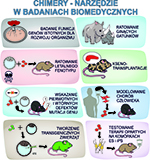Chimaeras with the contribution of the pluripotent stem cells as a tool in biomedical research
Chimaeras in biomedical research
DOI:
https://doi.org/10.18388/pb.2021_414Abstract
The CHIMAERA has been known as a mythic, fire-breathing monster containing a lion’s head, goat’s body, and serpent’s tail. In modern biotechnology, this term has been used to describe organisms composed of cells derived from at least two zygotes and thus differing genetically. Experimentally produced chimaeras have become an extremely valuable tool in biomedical research, used, among others, for investigating the developmental potential of cells, the differentiation processes that occur during embryogenesis, as well as for studying gene function, modelling human diseases, and developing new therapies. The interspecific chimaeras are also a promising approach for the generation of human organs for transplantation and saving endangered species. This article summarizes the current state of knowledge on chimaeras formed with the contribution of pluripotent stem cells and discusses the prospects and threats related to their use in basic research and medicine.
Downloads

Published
Issue
Section
License
Copyright (c) 2022 Advances in Biochemistry

This work is licensed under a Creative Commons Attribution 4.0 International License.
All journal contents are distributed under the Creative Commons Attribution-ShareAlike 4.0 International (CC BY-SA 4.0) license. Everybody may use the content following terms: Attribution — You must give appropriate credit, provide a link to the license, and indicate if changes were made, ShareAlike — If you remix, transform, or build upon the material, you must distribute your contributions under the same license as the original. There are no additional restrictions — You may not apply legal terms or technological measures that legally restrict others from doing anything the license permits.
Copyright for all published papers © stays with the authors.
Copyright for the journal: © Polish Biochemical Society.



